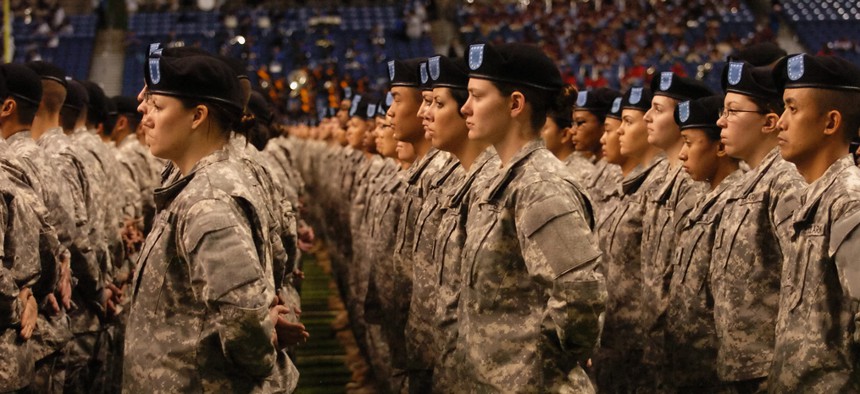
New soldiers take the oath of enlistment during a ceremony at the Alamodome in San Antonio, Texas. Sgt. 1st Class Scott Turner, U.S. Army via DoD Reserve Affairs Flickr.
With Shrinking Budgets, Pentagon Should Rely More on Guard, Reserve Troops
The Pentagon must think more creatively about how to structure and when to use reserve forces. By Ret. Lt. Gen. David Barno
The release of the 2014 National Defense Panel report landed with a quiet thud last week as most of Washington headed out for August vacations. Much delayed from its original congressionally mandated release three months after the Quadrennial Defense Review, the NDP review seemingly ignored today’s intractable budgetary realties by arguing for an even bigger defense budget. At the same time, it offered few tradeoffs and even fewer creative ideas for building a more effective and efficient military.
Among many opportunities missed in this consensus report was the chance to call for a new appraisal of the fractious compact among the nation’s active, Guard and reserve forces. In an era of ever-tightening budgets, the United States must think more creatively about both how to structure and when to use reserve component capabilities. As multiple reports have noted, these part-time forces are less expensive, while they retain critical equipment and skilled uniformed personnel that might otherwise be slashed from the force entirely as budgets plummet. The NDP does not mention the reserve component at all in its 17-page Executive Summary, and only sporadically throughout the remaining 64 pages of the text – and then largely to buttress current roles and missions.
A better recommendation from the NDP would call for a full re-examination of how the nation can derive more capability from the large investment already committed to the Guard and reserves. Over the last 13 years, Guard and reserve units and individuals played crucial roles across the battlefields in Iraq and Afghanistan -- indeed, many even in the active component would argue those wars would have been unsustainable without the all-out commitment of the nation’s reserves, the largest such commitment since the Korean War.
Guard and reserve formations ran convoys, patrolled in wide-ranging counter-insurgency operations, flew all manner of helicopters, fighter and transport aircraft – and were on balance indispensible to meeting U.S. military requirements in both conflicts. The level of trust between active duty leaders and their Guard and reserve counterparts grew strikingly. Reserve and Guard forces and their troops performed every conceivable mission, and generally did them well. Debates persist (especially among active duty officers) as to whether Guard units in particular were “interchangeable” with active duty formations. But there is no debate that the contributions of the reserve component were vital and irreplaceable.

Fast forward to today, where budget cuts have rapidly eroded that trust. As the Army has started to shrink, bitter disputes between the active Army and the Army National Guard leadership have broken out over aviation restructuring and cuts to Guard units. The wartime level of trust now looks to be a brief interlude in a long-standing politically tinged battle for resources – which is playing out publicly rather than behind closed doors. (Truth in advertising: the Air Force fought this public battle two years ago).
Enter the NDP. Given that it could have been a bully platform to advocate for change within the Defense Department, it fell flat in many areas – none more so than in thinking creatively about the role of Guard and reserve forces, and nowhere more so than in ground forces. The NDP called for restoring the Army and Marines to pre-9/11 levels, but it remained largely silent on the role of the reserve component – how it might take on different or more demanding roles, particularly in land warfare. The NDP’s proposal for more active duty forces to meet any conceivable international crisis is a happily satisfying answer – as long as cost is no object. Those days are over in the Defense Department, and across the federal budget writ large. In today’s environment, this is hard reality. A fresh look at how best to leverage the cost-effective investment in the nation’s reserve component makes sense for two reasons.
First, the reserves offer unique capabilities that should not be vested in the active component. Military missions that have a civilian world analog are growing – from cyber defense to information technology to supply chain management to telecommunications. Reserve formations that can leverage their location (think Silicon Valley) and their skilled people (think Google or Facebook employees) are powerful resources, since those personnel can perform the same tasks in uniform as they do daily for their civilian employers. World-class talent in these fields often comes clad in blue jeans and t-shirts, not camouflage. These types of skills cannot be replicated in the military by training 19-year-old privates fresh out of basic training – nor should they be.
Second, Guard and reserve formations in 2014 are repositories of some of the most modern weaponry and combat-experienced troops ever fielded by the nation. Their experience levels will soon eclipse the active duty force as more and more new soldiers and officers enter the active force in the next few years, while the reserves recruit experienced talent exiting active duty units during the drawdown. Selected numbers of these highly capable Guard and reserve formations need to be maintained at higher levels of combat readiness to offset a smaller active duty force. By law, the Guard and reserve are tasked with providing capabilities to backstop the active force where the active component capabilities are not adequate for the nation’s needs. In an era of fiscal austerity, those active force shortfalls will be large -- and will continue to grow.

Of all the options to offset active force shortfalls in wartime – including extended “stop loss,” greater use of contractors and longer deployments – reserve formations are arguably the most inexpensive and effective way to rapidly fill needed capabilities. This is not to suggest that active and reserve units should uniformly maintain the same levels of readiness in peacetime; if this were possible with no additional costs, there would be no need for an expensive active component. But it is not. The training and focus required to be ready to deploy to combat tonight is expensive and time-consuming. Active forces are best suited for this role. But their reserve component counterparts need to be ready to enter the fight sooner than they are structured to do so today. One model might continue to have those forces needed in the first four to six months of a conflict come primarily from the active force, while forces that deploy on slightly longer timeframes could be composite units that blend active, Guard and reserve troops. These blended units could realize significant savings over purely active duty formations while maximizing combat readiness and effectiveness across the force.
At the end of the day, the nation must rely upon active, Guard and reserve forces for its defense. Declining budgets across the federal government guarantee that there will be fewer active duty forces than may be needed to meet contingencies around the world. Only the Guard and reserve can fill that gap. It is well past time to seriously reexamine how to do that most effectively, before budget cuts drive thoughtless decisions.
David Barno is a Senior Fellow and Co-Director of the Responsible Defense Program at the Center for a New American Security. He served as commander of U.S. and coalition forces in Afghanistan from 2003 to 2005.




